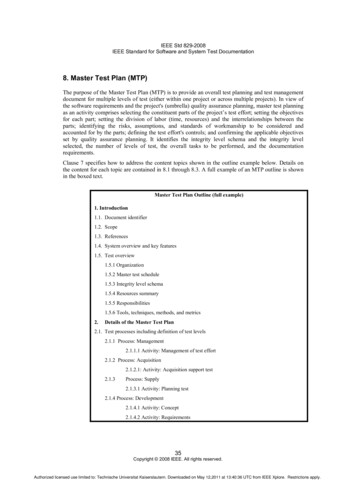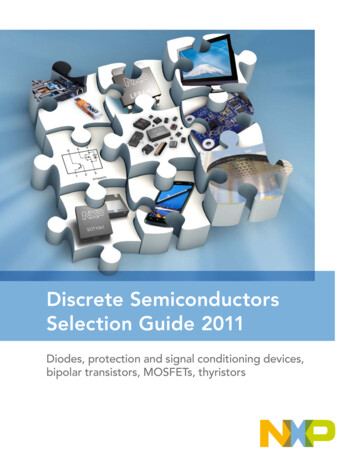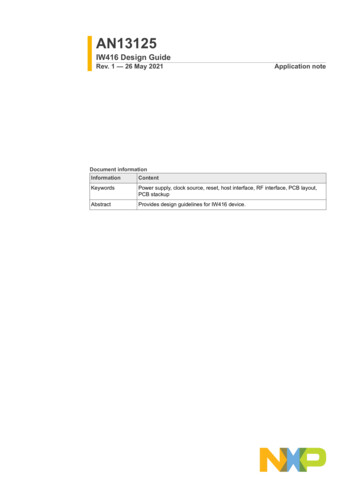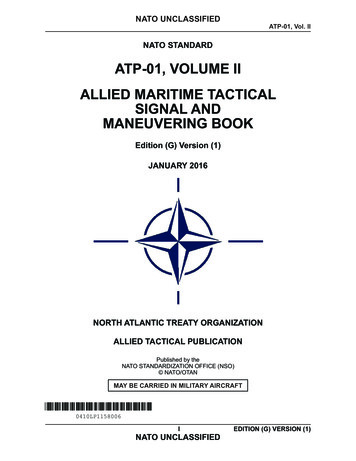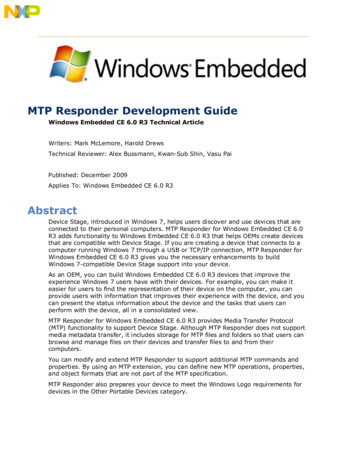
Transcription
MTP Responder Development GuideWindows Embedded CE 6.0 R3 Technical ArticleWriters: Mark McLemore, Harold DrewsTechnical Reviewer: Alex Bussmann, Kwan-Sub Shin, Vasu PaiPublished: December 2009Applies To: Windows Embedded CE 6.0 R3AbstractDevice Stage, introduced in Windows 7, helps users discover and use devices that areconnected to their personal computers. MTP Responder for Windows Embedded CE 6.0R3 adds functionality to Windows Embedded CE 6.0 R3 that helps OEMs create devicesthat are compatible with Device Stage. If you are creating a device that connects to acomputer running Windows 7 through a USB or TCP/IP connection, MTP Responder forWindows Embedded CE 6.0 R3 gives you the necessary enhancements to buildWindows 7-compatible Device Stage support into your device.As an OEM, you can build Windows Embedded CE 6.0 R3 devices that improve theexperience Windows 7 users have with their devices. For example, you can make iteasier for users to find the representation of their device on the computer, you canprovide users with information that improves their experience with the device, and youcan present the status information about the device and the tasks that users canperform with the device, all in a consolidated view.MTP Responder for Windows Embedded CE 6.0 R3 provides Media Transfer Protocol(MTP) functionality to support Device Stage. Although MTP Responder does not supportmedia metadata transfer, it includes storage for MTP files and folders so that users canbrowse and manage files on their devices and transfer files to and from theircomputers.You can modify and extend MTP Responder to support additional MTP commands andproperties. By using an MTP extension, you can define new MTP operations, properties,and object formats that are not part of the MTP specification.MTP Responder also prepares your device to meet the Windows Logo requirements fordevices in the Other Portable Devices category.
MTP Responder Development Guide1IntroductionMTP Responder for Windows Embedded CE 6.0 R3 provides enhanced Media TransferProtocol (MTP) functionality to support Windows 7 Device Stage. Device Stage offers acentral location in Windows for your users to discover and use their devices. When youinclude Device Stage support in your device, users can get detailed information aboutthe device, copy files to and from the device, run device-specific tasks, read a productmanual, and buy accessories for the device, all in one handy location. Device Stageprovides these capabilities without requiring the user to download or install software.For more information about Device Stage, see the Windows Device Experience site(http://go.microsoft.com/fwlink/?LinkId 132146).Device Stage communicates with your device over MTP; therefore, a device mustimplement MTP to support Device Stage. MTP enables an application on a computer, theMTP initiator, to control a portable device, the MTP responder, and transfer digitalmedia content and metadata between the computer and the device. The MTP initiatorand the MTP responder communicate over a communications link, or MTP transport,typically a USB or TCP/IP connection between the computer and the device. Devicesparticipate in Device Stage by implementing an MTP responder that can handle DeviceStage requests from an MTP initiator over one or more MTP transports. The MTPresponder functionality provided in this release is specifically designed to support theMTP initiator that is included in Windows 7 for Device Stage.This guide describes the Device Stage support provided by the MTP Responder, thefunctionality of each MTP Responder catalog item, MTP Responder limitations, andprerequisites for including MTP Responder in your device. A detailed step-by-stepDevice Stage implementation section explains how to install MTP Responder, how toconfigure device registry settings, how to add OEM Adaptation Layer (OAL) support,how to create presentation elements, and how to test your device with Device Stage. Asection on the MTP Responder design helps you learn more about the MTP Responderimplementation, modify the provided source code to add customizations andextensions, and download additional software development kits and programmingdocumentation for MTP and Device Stage development.Device Stage SupportWhen you include MTP Responder for Windows Embedded CE 6.0 R3 in your device, youcan choose from one of two supported levels of Device Stage presentation: baseline orcustom. The baseline presentation is the simplest and most essential devicepresentation level, while the custom presentation offers a richer set of features forusing your device.Baseline presentation displays a device icon, some textual information about yourdevice, and basic status information. MTP Responder provisions your device tocommunicate this essential information about the device and its contents to DeviceStage. Using this information, MTP Responder provides the following basic Device Stagecapabilities: View battery status Device Stage displays battery status information if yourdevice reports this information. View storage space Device Stage displays the amount of storage spaceavailable on your device if your device reports this information.Microsoft 2009
MTP Responder Development Guide Browse files File browsing capability lets a user manage files and folders on adevice using an Explorer window on the computer and transfer files between thedevice and the computer.These basic capabilities meet the minimum functionality requirements for Windows Logcertification for the Device Stage Other Portable Devices category. For more aboutDevice Stage categories, see the section Windows Logo Certification below. Your devicewill automatically create a baseline presentation when you include MTP Respondercatalog items in your OS design, configure registry settings with information about yourdevice, and implement OAL support for battery and storage status.The custom presentation extends the baseline presentation by adding enhancementssuch as branding logos, additional presentation images, custom tasks for managing thedevice, and links to provide users with access to product registration, support, manuals,applications, and accessories. To create a custom presentation, you first configure yourdevice to support the baseline presentation, and then you create a device metadatapackage for installation on the user’s computer to add additional end-user features. Youcan also implement extra functionality in your device to support custom Device Stagetasks as part of your custom presentation.Windows Logo CertificationWindows classifies devices into categories, based on the functionality of the device. TheMTP functionality in MTP Responder for Windows Embedded CE 6.0 R3 meets WindowsLogo certification requirements for a new category of devices called Other PortableDevices. This category includes portable navigation devices, consumer internet devices,digital picture frames, e-book readers, portable gaming devices, and set-top boxes. TheOther Portable Devices category is a member of the Portable Devices class. ThePortable Devices class also contains categories for cellular phones, digital cameras, andportable media players.Each device category has unique requirements that a device must meet to becompatible with Device Stage and qualify for a Windows Logo. The MTP componentsincluded in MTP Responder for Windows Embedded CE 6.0 R3 fulfill requirements onlyfor the Other Portable Devices category; however, you can extend the included MTPResponder source code to meet the requirements for other Windows device categories.For more information about Windows Logo certification and the requirements for devicecertification, see the Windows Logo Program(http://go.microsoft.com/fwlink/?LinkId 8772).MTP Responder ComponentsMTP Responder is comprised of several major functional blocks; the MTP ResponderStack, MTP Storage, and MTP Transports. You select MTP Responder functionality fromthe Catalog Items View in Platform Builder, where several new catalog items arepresented: MTP Responder (default), MTP Responder (minimal), MTP USB Transport,and MTP IP Transport. You cannot select MTP Storage as a separate catalog item; it isincluded only when you select the MTP Responder (default) catalog item. For moreinformation about catalog items, see the section Step 2 Add Device Stage CatalogItems to Your OS Design.Microsoft 2009
MTP Responder Development GuideMTP Responder StackThe MTP Responder Stack provides MTP router, dispatcher, and command handlerfunctionality to support Device Stage communication with the MTP initiator included inWindows 7. The MTP Responder Stack communicates with the user’s computer throughone or more MTP transports; you can configure the MTP Responder Stack to use a USBconnection, a TCP/IP connection, or both. You add MTP Responder Stack functionalityby adding one of the MTP Responder Stack catalog items in the Catalog Items View ofPlatform Builder. To support Device Stage, you must include the MTP Responder Stackin your OS design.MTP StorageMTP Storage adds file browsing capability over MTP by storing information about MTPobjects on your device. MTP Storage is optional for Device Stage support; however, filebrowsing over MTP is a minimum requirement for Windows Logo certification. For moreabout Windows Logo certification, see Windows Logo Certification.MTP TransportsThe MTP USB Transport provides MTP connectivity between the device and the user’scomputer through a USB connection. The MTP IP Transport provides MTP connectivitybetween the device and a user’s computer through a TCP/IP connection. You can useone or both of these transports in your device, but you must enable at least onetransport to support Device Stage.MTP transports can be used interchangeably. Users can copy files between the deviceand a Windows 7 computer over a USB connection or a TCP/IP connection. Also, usershave the ability to perform the same file browsing and device management operationsover a TCP/IP connection to the device as with a USB connection.LimitationsMTP Responder for Windows Embedded CE 6.0 R3 has several limitations with respectto file formats, properties, synchronization, and storage, which are described below.However, you can modify the provided MTP Responder source code to supportadditional file properties and formats, add synchronization support, or replace theincluded MTP Storage component with your own storage implementation. For moreinformation about these modifications, see the MTP Storage section of MTP ResponderDesign.File Formats and PropertiesMTP Storage supports only two object formats: Undefined (files) and Association(folders). Your device may store many different file formats (.mp3, .jpg, and so on),but MTP Storage treats them all as Undefined format. As a result, MTP Responderignores media properties found in video and audio files. Properties that are specific to media files, such as Artist, Title, and Album Namecannot be stored on the device. Windows Media Player cannot play files transferred over MTP from the devicebecause these files no longer have the properties that characterize media files.Microsoft 2009
MTP Responder Development GuideWindows Media Player only recognizes devices that support media file formatsand properties.Although MTP Storage does not support media file properties, media files managed byMTP Storage contain a minimum set of properties, such as the file name and file type,that must be present for use over MTP connections.File SynchronizationMTP Responder does not provide a mechanism for users to compare the contents offiles on the device with files on a computer or update files in either location based onthat comparison.Closed Storage ImplementationApplications cannot access storage data that is created and managed by MTP Storage;only MTP Responder Stack can access files and object metadata managed by MTPStorage.PrerequisitesTo build support for Device Stage into your device by using MTP Responder for WindowsEmbedded CE 6.0 R3, you use the tools that you normally use for Windows EmbeddedCE Development. You use a few additional tools and software development kits to testyour Device Stage presentation and create and test device metadata packages.Windows Embedded CETo support Device Stage, you must use Windows Embedded CE 6.0 R3. Earlier releasesof Windows Embedded CE do not include support for Device Stage. MTP Responder forWindows Embedded CE 6.0 R3 includes an MTP responder and related functionality thatis designed for servicing Windows 7 Device Stage requests.You use the Visual Studio integrated development environment (IDE) with the WindowsEmbedded CE Platform Builder toolset to design, create, build, test, and debug yourWindows Embedded CE-based run-time image. For more information about WindowsEmbedded CE development and Platform Builder, see the Platform Builder User’s Guide(http://go.microsoft.com/fwlink/?LinkId 178104).Metadata ToolsTo support the Device Stage custom presentation, you must assemble the files thatmake up a Device Stage custom presentation into a device metadata package forinstallation on the user’s computer (the baseline presentation does not require a devicemetadata package). For more information about creating a device metadata packagefor a custom device presentation, download the Windows Device ExperienceDevelopment Kit (http://go.microsoft.com/fwlink/?LinkId 178109).Windows 7Windows 7 provides an MTP initiator for testing your device in addition to theenvironment for building and testing device metadata packages.Microsoft 2009
MTP Responder Development GuideDevelopment StepsTo configure your Windows Embedded CE 6.0 R3 OS design to support Device Stage,follow these steps.1. Download and install MTP Responder for Windows Embedded CE 6.0 R3, available fromthe Windows Embedded CE 6.0 Download Center(http://go.microsoft.com/fwlink/?LinkId 179042).2. Create a baseline Device Stage presentation, which displays some identifying informationabout your device, your device icon, and a standard set of status elements and tasks.a. Choose and include MTP Responder catalog items in your OS design.b. Create a device icon image that represents your device.c. Populate device registry keys with information about your device.d. Develop your OEM Adaptation Layer (OAL) to support Device Stage status and taskelements.3. Optionally, create a custom Device Stage presentation, which includes a user interface foryour device that installs on Windows 7.a. Create a device metadata package that installs on the user’s computer.b. Develop any custom tasks in your device to support your device metadata package.c. Submit your device for Windows Logo certification.d. Submit your device metadata package to Microsoft for signing.When you complete steps 1 through 2 above, Device Stage generates a baselinepresentation for your device automatically. When you complete steps 1 through 3above, Device Stage displays your device with a custom presentation. Windows Logocertification and metadata signing are required only for a custom presentation.If you create a custom presentation, you can add status displays and tasks that arespecific to your device, promote your brand by adding custom graphic elements, andprovide users with links to product enhancements, registration sites, support sites, andproduct manuals. If you don’t create a user interface, then Device Stage shows thebaseline presentation for your device.The steps below and the links to related Web sites, software development kits, andadditional documentation will help you prepare your device for Device Stage.Device Stage ImplementationBy using MTP Responder, you take advantage of the MTP class driver support providedin Windows, thereby reducing the need to design, develop, and support a proprietarydevice connectivity solution. You provide a user with a simpler connection experiencebecause no additional software installation is necessary to communicate with Windows.To add Device Stage support to your device by using MTP Responder for WindowsEmbedded CE 6.0 R3, follow these steps:Step 1 Verify System RequirementsMTP Responder for Windows Embedded CE 6.0 R3 requires the following minimumsystem configurations.Microsoft 2009
MTP Responder Development GuideWindows VistaIf your computer runs on 32-bit Windows Vista, the following hardware and software isrequired.Hardware Requirements Personal computer with a 933 MHz or faster processor (2 GHz recommended) 512 megabytes (MB) of RAM (1 GB recommended) 18 gigabytes (GB) of available space on installation drive 1 GB of available space on system drive DVD-ROM drive Monitor that supports 1024 x 768 screen resolution with 16-bit colorSoftware Requirements Microsoft Visual Studio 2005 Visual Studio 2005 Service Pack 1 Visual Studio 2005 Service Pack 1 Update for Windows Vista Windows Embedded CE 6.0 R3Windows Embedded CE 6.0 is available from the Windows Embedded CE 6.0 DownloadCenter (http://go.microsoft.com/fwlink/?LinkId 179042).Windows XPIf your computer runs on 32-bit Windows XP Service Pack 2, the following hardwareand software is required.Hardware Requirements Personal computer with a 933 MHz or faster processor (2 GHz recommended) 512 megabytes (MB) of RAM (1 GB recommended) 18 gigabytes (GB) of available space on installation drive 1 GB of available space on system drive DVD-ROM drive Monitor that supports 1024 x 768 screen resolution with 16-bit colorSoftware Requirements Microsoft Visual Studio 2005 Visual Studio 2005 Service Pack 1 Windows Embedded CE 6.0 R3Windows Embedded CE 6.0 is available from the Windows Embedded CE 6.0 DownloadCenter (http://go.microsoft.com/fwlink/?LinkId 179042).Microsoft 2009
MTP Responder Development GuideStep 2 Add Device Stage Catalog Items to Your OSDesignTo add Device Stage support to your OS design, add one or more of the followingcatalog items and SYSGEN variables to your OS design. Use the MTP Responder(default) catalog item unless you intend to modify or replace the provided transportcomponents. If you do not use MTP Responder (default), you must include MTPResponder (minimal) and at least one transport or use equivalent components of yourown design.Table 1 - SYSGENsCatalogitemSYSGEN variableDescriptionMTPResponder(default)SYSGEN MTP RESPONDERAdds all Device Stage components:MTP Responder Stack, MTP Storage,and all MTP transports. Includes thesoftware components necessary toadd Device Stage support on a CE6.0 R3 device.MTPResponder(minimal)SYSGEN MTP RESPONDER MINAdds only the MTP Responder stack;does not add MTP Storage or MTPtransports.MTP USBTransportSYSGEN MTP RESPONDER USBAdds MTP over USB transportfunctionality.MTP IPTransportSYSGEN MTP RESPONDER IPAdds MTP over IP transportfunctionality.For information about selecting catalog items, see Adding Catalog Items to an OSDesign (http://go.microsoft.com/fwlink/?LinkId 179330). For information about settingSYSGEN variables, see Setting or Clearing a Sysgen Variable(http://go.microsoft.com/fwlink/?LinkId 179331).Step 3 Configure Registry Settings in Your OSDesignTo configure registry settings in your OS design to support Device Stage, modify thedatasync.reg file, which can be found at this location:% evice InformationTo identify and install the device in Windows, associate the device with a metadatapackage on the computer, and display strings in Device Stage for a baselinepresentation, you must add the device information entries listed in Table 2 to theregistry key:HKEY LOCAL MACHINE\Software\Microsoft\MTP\ResponderMicrosoft 2009
MTP Responder Development GuideTable 2 - Device Information Registry NameREG SZWindowsEmbeddedGenericDeviceThe device model name that MTPuses to respond toGetDeviceInfo requests, forexample, “Contoso GPS”.DeviceFriendlyNameREG SZWindowsEmbeddedGenericDeviceThe friendly name that MTP usesto respond toGetDevicePropDesc requests,for example “Contoso GPS”.ModelIDREG SZGeneratedif notspecifiedA 128-bit GUID that associates adevice with a Device Stagepresentation, regardless of howthe device is connected to thecomputer. For or more information abouthardware IDs and model IDs, seethe following documents inthe Windows Device ExperienceDevelopment Kit(http://go.microsoft.com/fwlink/?LinkID 178109): Windows 7 Device StagePortable Device ClassDevelopment Guide Windows 7 Device StageReference GuideSee also ModelID(http://go.microsoft.com/fwlink/?LinkID 179337).If you do not specify theModelID, MTP Responder willgenerate one for you. See thenote below for disabling ModelID.DeviceVersionREG SZNo defaultThe version information that MTPuses to respond toGetDeviceInfo requests, forexample “1.2”.Microsoft 2009
MTP Responder Development GuideFunctionalIDREG SZGeneratedif notspecifiedThe 128-bit GUID—permanentfor the life of the device—thatuniquely identifies an MTP devicethat is connected via multipletransports, for .For more information about thefunctional ID, see the MTPDevice Services ExtensionSpecification (http://go.microsoft.com/fwlink/?LinkID 178887).If you do not specify thefunctional ID, MTP Responder willgenerate one for you at deviceboot time. See the note belowfor disabling FunctionalID.ContainerIDREG SZGeneratedif notspecifiedAn identifier that informsWindows 7 that multiplefunctional device instancesactually originate from the samephysical device.For more about container IDs,see Multifunction Device Supportand Device Container Groupingsin Windows 7(http://go.microsoft.com/fwlink/?LinkID 158386).If you do not specify theContainerID, MTP Responder willgenerate one for you at deviceboot time.Note Device Stage displays your device as a “Composite (Multi-Transport) Device”even if the device has only one MTP transport configured. Because MTP Responderalways reports a functional ID to the MTP initiator on the user’s computer (even if youdo not configure FunctionalID in the registry settings above), Device Stage assumesthat your device supports MTP connections over more than one transport. For moreabout multi-transport devices, see Multi-Transport Devices in Windows 7(http://go.microsoft.com/fwlink/?LinkID 179542).To disable the FunctionalID or ModelID settings, modify the devicesettings.xml file,which can be found at this location:% s.xmlMicrosoft 2009
MTP Responder Development GuideIn DevicePropertiesSupported , find the declarations for the FunctionalID andModelID properties. DevicePropertiesSupported Base 0x5001 /Base !- Base 0xD301 /Base !- Base 0xD302 /Base !- Base 0xD401 /Base !- Base 0xD402 /Base !- Base 0xD405 /Base !- /DevicePropertiesSupported BATTERYLEVEL -- FUNCTIONID -- MODELID -- SYNCHRONIZATIONPARTNER -- DEVICEFRIENDLYNAME -- DEVICEICON -- When you remove the FUNCTIONID element shown above, MTP Responder will notreport a functional ID to the MTP initiator, even if you specify the FunctionalID in theregistry. When you remove the MODELID element shown above, MTP Responder willnot report a model ID to the MTP initiator, even if you specify the ModelID in theregistry.Transport InformationIf you are using the MTP USB transport, you must set the product ID and vendor ID(listed in Table 3) in the registry key:HKEY LOCAL MACHINE\Drivers\USB\FunctionDrivers\MTPUSBFnTable 3 - USB Transport Registry G DWORD0x0622A bus-specific product identifierthat associates a device with aDevice Stage presentation, forexample, DWORD:0622. For moreinformation, see USB FunctionClient Driver Registry Settings(http://go.microsoft.com/fwlink/?LinkId 179334).idVendorREG DWORD0x045EA vendor ID is the 4-digit vendorcode that the USB committeeassigns to the vendor. Rememberto change this value to yourvendor ID; 045E is reserved foruse by Microsoft.For more information, see: Device nk/?LinkId 146573) Identifiers for USB Devices(http://go.microsoft.com/fMicrosoft 2009
MTP Responder Development Guidewlink/?LinkID 179341) USB Function Client DriverRegistry Settings(http://go.microsoft.com/fwlink/?LinkID 179334)To obtain a vendor ID, seethe USB Web site(http://go.microsoft.com/fwlink/?LinkID 119292).See also Standard USB Identifiers(http://go.microsoft.com/fwlink/?LinkID 179342).If you are using the MTP IP transport, you must set the product description and themanufacturer URL (listed in Table 4) in the registry key:HKEY LOCAL MACHINE\Software\Microsoft\MTP\ResponderTable 4 - IP Transport Registry riptionREG SZEmptyString/NULLThe user-friendly description ofthe device. For example,“Portable Navigation Device with4.3 inch screen”.ManufacturerURLREG SZEmptyString/NULLThe URL for your company’s Website.Storage ConfigurationFor the user to be able to browse files on the device from their computer, you mustdefine a single storage location for MTP objects (files and folders) on the device. Youcan specify the root of your device or one of its subdirectories as the MTP storagelocation.To configure the MTP storage location on your device, configure the StorageRoot,StorageDescription, VolumeIdentifier, and AccessCapability settings (listed in Table 5)in the registry key:HKEY LOCAL MACHINE\Software\Microsoft\MTP\ResponderTable 5 - Storage Registry SettingsMicrosoft 2009
MTP Responder Development GuideNameTypeDefaultValueDescriptionStorageRootREG SZGeneratedif notspecifiedThe path to the MTP storagelocation. This path will appearas the root of the device’sstorage in Device Stage.If you do not specify thedefault value, MTP Responderwill default to the MyDocuments folder. If the MyDocuments folder is notavailable, MTP Responder willuse \MTPStorageRoot.For more information aboutstorage representation on MTPdevices, see the MTP inkID 137101).StorageDescriptionREG SZ“MTPStorage”A human-readable string, forexample, “My Storage”.VolumeIdentifierREG SZ“MTPVolumeIdentifier”A unique identifier, such as aserial number. Only the first128 characters are used toidentify the device, and theymust be unique for the device.AccessCapabilityREG DWORDACCESS CAPABILITY READ WRITE 0Identifies any write-protectioncharacteristics that globallyaffect storage. You can setAccessCapability to one of thefollowing values:ACCESS CAPABILITY READWRITE 0ACCESS CAPABILITY READ ONLY WITHOUT OBJECT DELETION 1ACCESS CAPABILITY READ ONLY WITH OBJECT DELETION 2Microsoft 2009
MTP Responder Development GuideDevice Metadata ServiceTo transfer a custom presentation from the device to the computer when the devicefirst connects to the computer, you must modify the Path, ContentID, and Flags registrysettings (listed in Table 6) in the registry key:HKEY LOCAL MACHINE\Software\Microsoft\MTP\Responder\Metadata\ Locale where Locale is the value from the Locale element in PackageInfo.xml in thedevice metadata package.Table 6 - Metadata Service Registry SettingsNameTypeDefaultValueDescriptionPathREG SZNodefaultThe absolute path on the system to themetadata package for the locale, for exampleHard Disk1\WDS Metadata.ContentIDREG SZNodefaultA unique GUID string in the registry in CLSIDformat ( “{xxxx- }” ) that is assigned by theWindows Logo signing process, ”.FlagsREG DWORDNodefault1 to designate that this package has theattribute locale default “true” in thePackageInfo.xml file in a device metadatapackage; otherwise, 0 (zero).For a list of locale identifier strings, see Locale Identifier Constants and Strings(http://go.microsoft.com/fwlink/?LinkID 63026).For more information about how Windows 7 uses the locales specified in devicemetadata packages, see How to Localize Device Stage Experiences in the Windows 7Device Stage Reference Guide in the Windows Device Experience Development Kit(http://go.microsoft.com/fwlink/?LinkID 178109).Step 4 Provide OAL Support for Device StageWhen a computer issues an MTP GetDeviceInfo request to your device, the MTPResponder gets information about the device from the k/?LinkID 179347) function.To set that information, when you develop an OEM Adaptation Layer (OAL), you issueadaptation layer I/O control codes (IOCTLs) to inform the kernel of information aboutyour device by calling the D 179348) function on device startup. You usethe IOCTLS described below to set the manufacturer name and the device ID and addsupport for the battery level and free storage displays.Microsoft 2009
MTP Responder Development GuideManufacturer NameTo set the manufacturer name, use the following code, where lpOutBuf is a pointer to abuffer that contains the string representing your manufacturer name, andlpBytesReturned is the number of bytes that you wrote to lpOutBuf.OEMIoControl(IOCTL HAL GET DEVICE INFO,SPI )Device IDTo set the device ID, use the following code, where lpOutBuf is a pointer to a bufferthat contains the string representing the device ID, and lpBytesReturned is the numberof bytes that you wrote to lpOutBuf.OEMIoControl(IOCTL HAL GET DEVICE INFO,SPI GETUUID,4,lpOutBuf,lpBytesReturned)For more information about the device ID, see Device ID(http://go.microsoft.com/fwlink/?LinkID 179344) and How do I get the "right" DeviceID? (http://go.microsoft.com/fwlink/?LinkID 179345).Battery LevelTo add support for battery level, implement theIOCTL BATTERY GETSYSTEMPOWERSTATUSEX2 control in your battery drivercode. This control returns a SYSTEM POWER STATUS EX2 structure that reports thebattery level in the BatteryLifePercent field. Battery level is expressed as apercentage, with a value ranging from 0 to 100. The value that
MTP Storage contain a minimum set of properties, such as the file name and file type, that must be present for use over MTP connections. File Synchronization . MTP Responder does not provide a mechanism for users to compare the contents of files on the device with files on a computer or update files in either location based on that comparison.


